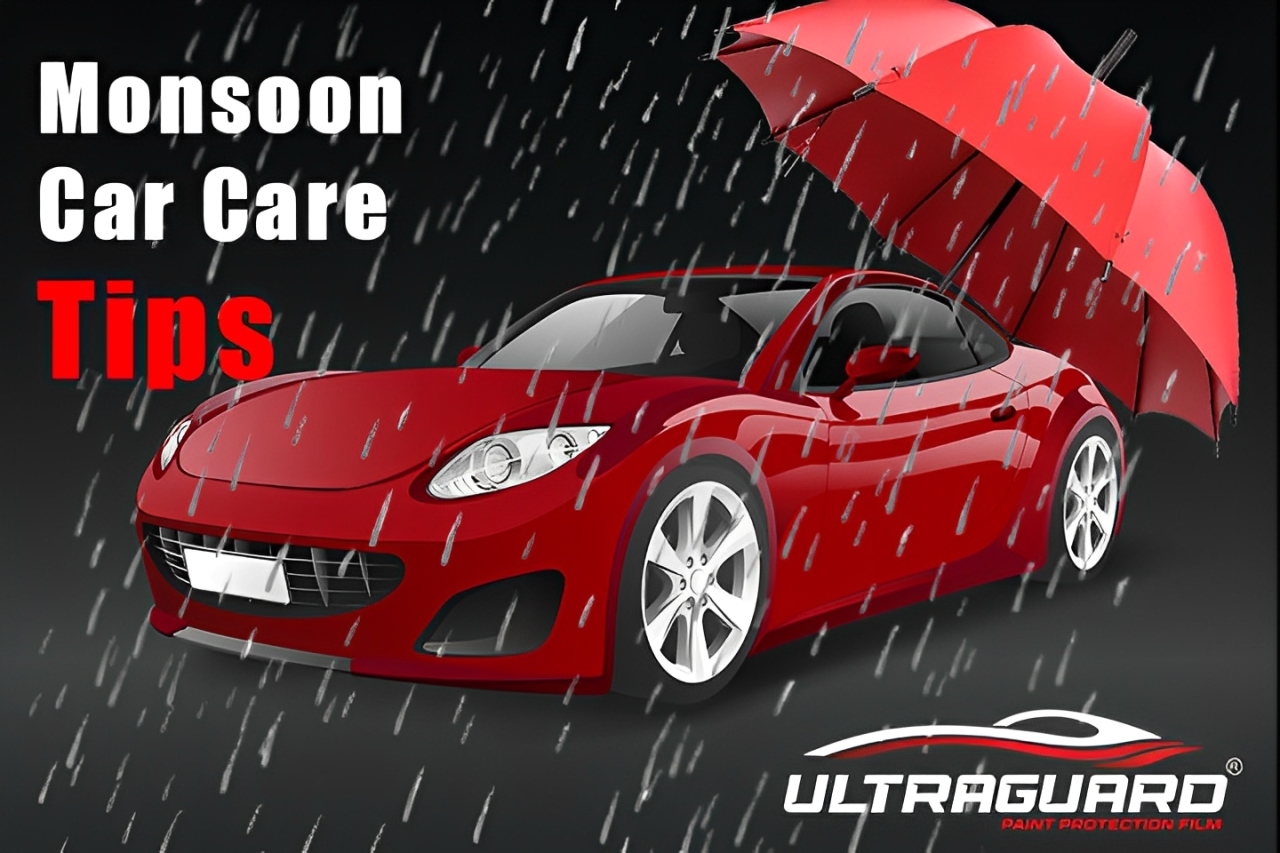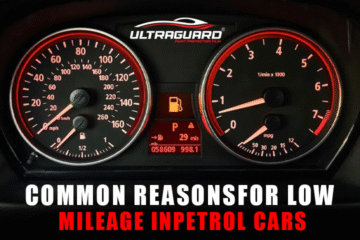The arrival of the monsoon provides relief from the burning heat but also presents important challenges for car owners. Rainy roads, reduced visibility, sloppy conditions, and increased humidity can affect the car’s performance, appearance, and safety. Car preparation for monsoon or doing monsoon car maintenance for the rainy season is not just a smart step; keeping the vehicle running smoothly and ensuring your safety on the road is necessary.
This blog will guide you through practical and preventive steps to car preparation for monsoon or monsoon car maintenance for the rainy season, ensuring maximum safety, comfort, and security.

Monsoon car care tips
Below, you will see tips on monsoon car maintenance.
1. Check your tire – your first line of defence
Your tires are the only part of your vehicle that directly touches the road. During the monsoon season, a combination of wet roads, oil’s versatility, and low traction increases the risk of skidding or sliding. The well-maintained tire becomes the first and most important monsoon car maintenance and protection line.
What to check:
Tread depth:
Adequate running depth ensures better water displacement and prevents hydroplaning. A sharp depth of at least 2.5–3 mm is required. If it were a bit less, your tires could fail to catch a grip on wet roads effectively.
Tire pressure:
Tires lose pressure faster in hot and humid weather; therefore, wrong inflation, whether too much or too little, can cause uneven wear and poor handling.
Cracks, cuts, or bulges are signs of aging or internal damage. Driving with such deficiencies is risky when response time and control are compromised during severe rain.
Pro Tip:
You should rotate your vehicle tires every 7,000-10,000 km to ensure you go where you want. This improves life and maintains the same grip on all wheels.
2. Inspect and change the wiper blade
The wiper often does not consider buying monsoon car maintenance until too late. When it rains, worn-out wiper blades can leave streaks and smears on the windshield, dangerously affecting visibility and making driving difficult.
What to check:
Rubber conditions:
Inspect for signs of wear, such as cracking, demolition, or hardening of the rubber. If the blade leaves the line or squeaks while operating, it’s time to change it.
Motor efficiency:
A slow or noisy motor can indicate mechanical problems. Make sure the wiper blades go smoothly over the glass without any tweaking.
Pro Tip:
Top your windshield washing machine with rain-repellent liquid. This cleans the windshield and helps the water beads get off it faster.
3. Monsoon car maintenance is to test your brake system
The brakes for wet weather driving must be in the top position. Water on the roads can reduce friction and increase the stopping distance, making it important that your brake system works effectively.
What to check:
Break Pad:
It should be thick and durable. If you hear shrieking or grinding, you can change them immediately.
Brake fluid:
Over time, brake fluid absorbs moisture, reducing efficiency. Check the level and change the old liquid if necessary.
Brake counter status:
Check for rust or grooves, especially if your car has become inactive. Clean or resurface the disc if necessary.
Pro Tip:
Run slowly through the puddles and gently press the brakes later so that they can help dry and restore the grip quickly.
4. Make sure appropriate headlights and tiller functionality
Seeing and looking at your car’s lighting becomes important in a state of low visibility, such as heavy rain, fog, or dusk.
What to check:
Headlights, taillights, fog lights:
Ensure all bulbs are working and illuminated at full brightness.
Indicators and brake lights:
Confirm these work immediately, especially when braking or in traffic.
Lens cover:
Over time, plastic covers become blurred. Clean or replace them to improve light production.
Pro Tip:
Apply a coat of polish or wax on the headlight cover. It can help prevent the beams from becoming less effective in unfavourable weather conditions.
5. Monsoon car maintenance Sealing Control – Protect the cabin from water input
Water leakage can damage the vehicle’s electrical systems, interior, and other major components. During the monsoon, secure the cabin from water to avert any water damage, as it can affect the vehicle’s internal systems and comfort.
What to inspect:
Door and window seal: Press them gently if the door and window seals are soft and springy. Hard or cracked seals are ineffective and need to be replaced.
Windshield edges:
Look carefully for signs of air bubbles or lifting edges that may indicate sealant or adhesive breakdown.
Sunroof drain:
If you have a sunroof, ensure the drainage ducts are not blocked or closed, as the water that might accumulate here can drip into the cabin.
Pro Tip:
Use a rubber conditioner or silicone spray on all seals to maintain flexibility and extend their life.
6. Monsoon car maintenance – Protection of the body against rust
Continuous rain, puddles, mud, and frozen water at the bottom of the vehicle can accelerate wear.
What to do:
Anti-residual coating: A professional coating under the body creates a protective barrier to moisture and salts. Consider this investment, especially if you live in a coastal or high-bar area.
Regular cleaning:
After every long or sloppy drive, rinse the undercar to prevent debris from construction.
Pro Tip:
Don’t ignore unusual, wonderful sounds. The mud can be hard and stick in parts such as wheel arches, affecting suspension or handling.
7. Monsoon car maintenance includes Battery health, as moisture can be a threat
Moisture and exposure to water can cause electrical defects and battery breakdowns, especially in old batteries.
What to check:
Battery time:
Clean white or green rust using a brush and baking soda solutions.
Battery tender:
If the battery is over three years old and often dies to crank or is worn, you can change it prematurely.
Wiring:
Observe cables for exposed ends or rats during the rainy season.
Pro Tip:
Apply petroleum jelly or battery terminal grease to prevent oxidation and improve the current flow.
8. Maintain a clean and dry interior for your monsoon car maintenance
A damp interior feels uncomfortable and can lead to health hazards such as cold and mould.
What to do:
Use fabric mats. They are more efficient and can dry in the sun. Rubber mats often allow the water to pool.
Repeated vacuuming:
You should clean and dry your upholstery at least once a week.
Moisture absorptions:
Use charcoal bags, silica canvas, or a dehumidifier bag to control cabin moisture.
Pro Tip:
Window visors allow you to open the windows slightly for ventilation, even when it rains, and safeguard against moisture.
9. Check the Heating, Ventilation, AC (HVAC), and Defogger system
When the hot air inside your car meets the cold, damp air outside, fog forms on the windows while you drive.
What to check in this monsoon car maintenance:
AC system:
Make sure it defrosts the windshield quickly and evenly.
The rear window was deformed due to broken heating lines or an unsuccessful switch.
Cabin air filter:
If dirty, the airflow decreases, making it ineffective.
Pro Tip:
Use AC in “Fresh Air” mode to quickly clean the fog, not just recreation mode.
10. Make sure proper drainage
Blocked drainage can cause flooded areas in boots, footwells, and hoods; therefore, the mechanical and aesthetic components get damaged.
What to inspect:
Windshield wiper drain:
Located under the wiper; Often gets blocked with leaves and dirt.
Door and sunroof drain:
Small drain holes are located at the foot of each door; ensure each is clean.
Boot drain: Especially important in hatchbacks and sedans.
Pro Tip:
Use a thin cord, brush, or air blower to clean narrow or curved drainage ducts.
11. Create an emergency kit
The monsoon brings unexpectedly inflated roads, breakdowns, or being stranded without help. So it’s better to have pre-monsoon car maintenance equipment for the good:
- Tow rope
- Jumper cable
- Torch with battery
- Emergency alert triangle
- First aid kit
- Raincoat or umbrella
- Extra footwear and a dry towel
- Power Bank or 12V car charger
Pro Tip:
Store these important things in a waterproof case and keep them easily accessible in the trunk.
12. Clean the car paint and glass and keep it safe
Rainwater contains acid and contamination that can dull your paint or engrave your glass surfaces.
What to do:
Wax your car:
A good wax improves the brightness, reduces spots, and stops the peeling.
Use rainy glass treatment:
It improves visibility by letting rain roll quickly.
Clay bar treatment:
The clay bar assists in removing surface-bound impurities and environmental toxins, smoothing the surface before any detailing work.
Pro Tip:
For first-class safety, consider ceramic or PPF Coating. These coatings provide a hydrophobic barrier that prevents rain and mud.
13. Monsoon car maintenance is done by maintaining the fuel tank
Keeping the tank maintained is almost completely ignored during the monsoon.
What to do:
Full Tank:
Prevents condensation inside the tank, which can pollute your fuel.
Check the fuel cap. A loose or grated hood can allow water to get into the tank. Replace it if it’s incorrect.
14. Look for mice or rats
They can chew through insulation, cabling, and other vulnerable components.
Prevention tips:
Parks in busy areas or properly lit areas
Use a rodent repellent spray.
Keep tobacco leaves or moth balls in a mesh towel or bag first, then place it in the engine well (safe, away from hot components)
15. Plan smart routes and run carefully
Although your car is monsoon-oriented, the road situation can be unexpected.
Smart practice:
Use navigation apps to avoid waterfalls or traffic jams.
Run slowly and hold safe brake spacing.
Avoid sudden changes of direction or braking.
Use dangerous lights under low visibility.
Don’t cross more than half the water from the height of your tire.
What are you not going to do during the monsoon?
Do not ignore small leaks: they can give rise to electrical damage or mildew.
Do not run on a worn tire or brake: it is risky in some seasons, but suicide in rain.
Do not leave the car inactive for long periods: Moisture can affect circulation and moving parts.
Conclusion
Car preparation for monsoon or performing monsoon car maintenance for the rain is more than preventative maintenance; it’s about your safety and that of your passengers. This extensive checklist will better equip you to handle smooth roads, poor visibility, and sudden downpours.
The monsoon tests your driving skills and the car’s emergency preparedness. A little active monsoon car maintenance goes a long way toward ensuring that you drive safely, avoid breakdowns, and protect the life of your vehicle. Following the tips above, you can do car preparation for monsoon and the equipment to cope with the monsoon-related challenges.
Therefore, you can protect your car well during this monsoon season, along with paint protection film.
FAQS
1. Why is it important to do monsoon car maintenance?
Preparing your vehicle for the monsoon is critical to avoid damage in heavy rain. Proper preservation enables you to ensure the car’s protection, increases visibility, and averts issues, including electrical damage, rust, and tire wear.
2. What are the most essential regions to consider in preparation for monsoon season?
Be aware to check the wipers, tires, brakes, air conditioner, and seal. Also, ensure the battery is in the proper condition and open the drainage ducts to prevent water from accumulating. Finally, test out your lighting for visibility in case of rain.
3. How must I test if the car’s wipers are prepared for the monsoon?
Inspect the wiper blade for signs and symptoms of harm, including cracks or divisions. You can change them if they go away from the lines on the windshield or fail to drain the water well. Ensure the wiper fluid is on top and the engine works evenly.
4. How often should I replace the air filter before the monsoon season?
Updating the air filter at least every 12,000 to 15,000 kilometres is recommended. However, if you observe much lower air quality or AC performance, updating the filter to ensure better airflow for the monsoon season can help to avoid mould growth.
5. Are my tires steady for moist situations?
Check the tire tread intensity to ensure the right grip on moist roads. Tires must have a speedy depth of at least 1.6 mm. If they are placed on, you can alternate them with new designs for a higher grip in wet and dry situations.
6. How can I prevent rusting all through the monsoon?
Wash the car regularly to remove dust and frozen salt, which can cause rust. Thoroughly clean the undercarriage and wheel wells. Also, the protective wax coating should be applied to avert any moisture that directly influences the paint or metal surfaces.




0 Comments